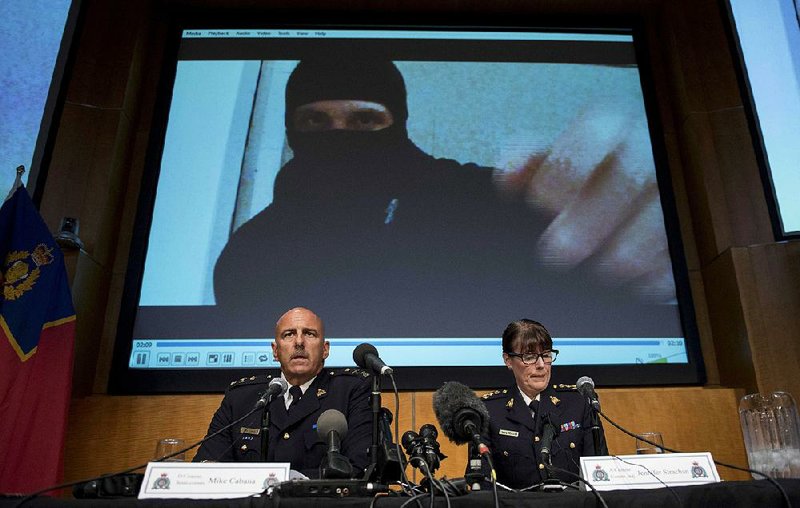TORONTO -- A tip from the FBI triggered what Canadian police on Thursday called a "race against time" as police worked to identify and find a balaclava-wearing, would-be suicide bomber they feared was on the verge of committing a terror attack in Canada.
RELATED ARTICLES
http://www.arkansas…">20 die in strikes on ISIS in Syria http://www.arkansas…">Libyan says Sirte '70%' free of ISIS http://www.arkansas…">ISIS reports too rosy, GOP panel concludes
Aaron Driver, a Canadian man previously banned from associating with Islamic State extremists, prepared a martyrdom video and was about to commit a terrorist attack but was killed Wednesday after he detonated his explosive device in a taxi and was shot at by officers who say they thwarted the plot, according to police. Police say they were tipped off Wednesday morning by U.S. authorities who provided a screen shot of a masked man threatening a terror attack, police said.
The man planned to carry out a suicide bombing in a public area in an urban center during rush hour, said Mike Cabana, deputy commander of the Royal Canadian Mounted Police. He identified the man as Driver, 24, originally from Winnipeg, Manitoba.
Jennifer Strachan, commander of the Canadian force, said Driver was intercepted by police as he got into a taxi with a backpack and that Driver detonated an explosive device, injuring himself and the taxi driver, before police shot at him. It was unclear whether Driver died as a result of the shrapnel or a police bullet.
After being tipped off by the FBI, Canadian police worked furiously to find out who the masked man was. Police said Driver was identified as the person in the so-called martyrdom video and that he planned an attack within 72 hours.
"It was a race against time," Cabana said.
In the video, aired during a news conference in Ottawa, a masked Driver is seen railing against Western "enemies of Islam" and warning that the only solution would be the "spilling of your blood." He pledges allegiance to Abu Bakr al-Baghdadi, the Islamic State group's leader, and threatens an attack against Canada.
Driver had been on the radar of authorities for at least a year, as authorities believed he was a threat because he could help terror groups. Driver gave a media interview during which he expressed support for terror attacks in Canada and expressed interest in traveling to join the Islamic State. But Driver, who was living with his sister, was not under surveillance at the time of the interview.
The police operation involving Driver took place Wednesday night in the southern Ontario town of Strathroy, 140 miles southwest of Toronto.
"If he had gotten out of that [area] before we got there, the scenario would have ended a lot differently. I'm positive of that," Strachan said.
Transit agencies in Toronto, Canada's largest city, were warned of a security threat before police confronted Driver. Brad Ross, spokesman for the Toronto Transit Commission, said the agency was made aware of a terror threat investigation early the previous day, but noted that it had no specifics attached.
He said that as a precaution, a "vigilance notice" was issued to all employees, encouraging them to speak up if they saw something of concern. Regional transit lines also were advised of a security threat.
"This case is an example of the strong cross-border law enforcement cooperation that exists between Canada and the United States. Our partnership reflects our joint commitment to protecting the safety of our citizens," U.S. Ambassador to Canada Bruce Heyman said in a statement.
Canadian Public Safety Minister Ralph Goodale thanked the FBI on Thursday and said he spoke with U.S. Attorney General Loretta Lynch.
Amarnath Amarasingam, a postdoctoral fellow at Dalhousie University who studies radicalization and terrorism, maintained in 2015 that Driver had posted for several months on social media about disliking Canada and about a desire to move overseas.
Driver was first picked up in Winnipeg in June 2015.
He was under a court order from earlier this year not to associate with any terrorist organization, including the Islamic State group. In February, Driver's lawyer and the prosecutor agreed to a peace bond, which imposes limits on a person's activities, stating there are "reasonable grounds to fear that he may participate, contribute directly or indirectly in the activity of a terrorist group."
When Driver was released, he was ordered to wear a GPS tracking device and banned from going on the Internet or having any communication with the Islamic State group, including wearing or carrying anything with an Islamic State logo.
His bond conditions drew criticism from the Manitoba Association of Rights and Liberties. Later, the government announced that some of the strict conditions had been lifted and that he would not go to trial.
Goodale said he had spoken to Prime Minister Justin Trudeau about the police operation Wednesday night "to confirm that public safety has been and continues to be properly protected."
He said the Royal Canadian Mounted Police, the Canadian Security Intelligence Service and other police and security agencies were involved in the operation. He also said the national terrorism threat level for Canada remains at "medium," where it has stood since the fall of 2014.
A Section on 08/12/2016
